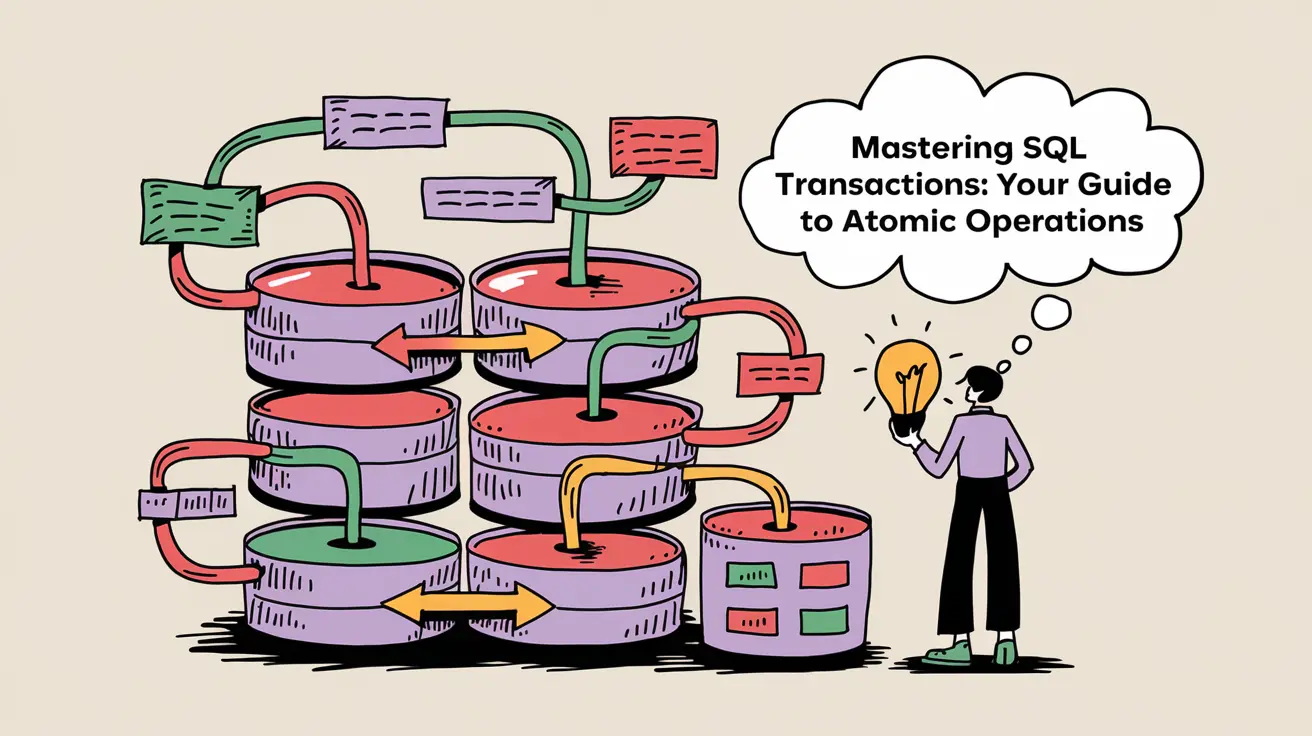Understanding SQL Transactions: The Backbone of Data Integrity
SQL transactions are a powerful feature in database management systems. They group multiple SQL statements into a single, atomic unit of work. This means all operations within a transaction either succeed together or fail together, maintaining data consistency. Transactions are crucial for ensuring data integrity in complex database operations.
Let’s dive deeper into the world of SQL transactions. Imagine you’re transferring money between bank accounts. You’d want to ensure that the deduction from one account and the addition to another happen simultaneously. If either operation fails, the entire transfer should be canceled. This is where transactions shine.
Transactions follow the ACID properties: Atomicity, Consistency, Isolation, and Durability. These properties guarantee that database transactions are processed reliably. Atomicity ensures that all operations in a transaction are treated as a single unit. Consistency maintains the database in a valid state before and after the transaction. Isolation keeps concurrent transactions separate until completion. Durability guarantees that committed transactions persist, even in case of system failures.
Understanding these properties is key to leveraging the full power of SQL transactions. They form the foundation of reliable database operations, especially in multi-user environments where data integrity is paramount. As we explore further, you’ll see how these concepts apply in real-world scenarios, making your database operations more robust and reliable.
The Anatomy of SQL Transactions: From BEGIN to COMMIT
Every SQL transaction has a specific structure. It starts with a BEGIN statement, followed by one or more SQL operations, and ends with either a COMMIT or ROLLBACK statement. The BEGIN statement marks the start of a transaction. All subsequent operations are part of this transaction until it’s explicitly ended.
Here’s a basic example of a transaction structure:
BEGIN;
UPDATE accounts SET balance = balance - 100 WHERE account_id = 1;
UPDATE accounts SET balance = balance + 100 WHERE account_id = 2;
COMMIT;In this example, we’re transferring $100 from account 1 to account 2. The transaction ensures that both updates occur together. If any part fails, the entire transaction is rolled back, maintaining the original account balances.
The COMMIT statement finalizes the transaction, making all changes permanent. If something goes wrong during the transaction, you can use ROLLBACK instead of COMMIT. This undoes all changes made since the BEGIN statement, returning the database to its previous state.
Some database systems also support savepoints within transactions. These allow you to roll back to a specific point in the transaction without discarding all changes. This can be useful in complex transactions where you want finer control over error handling.
Why Use Transactions? Real-World Scenarios and Benefits
SQL transactions offer numerous benefits in real-world applications. They’re essential in scenarios where data integrity is crucial. Let’s explore some common use cases where transactions shine.
- Financial Systems: In banking applications, transactions ensure that money transfers are atomic. When moving funds between accounts, both the debit and credit operations must succeed or fail together.
- E-commerce: During checkout processes, transactions guarantee that order details, inventory updates, and payment processing are synchronized. If any step fails, the entire order is canceled.
- Booking Systems: For flight or hotel reservations, transactions ensure that seat assignments or room bookings are consistent, even when multiple users are booking simultaneously.
- Data Migration: When moving data between systems, transactions can ensure that all related data is transferred completely or not at all, maintaining referential integrity.
- Multi-step Forms: In web applications with multi-step forms, transactions can be used to save all form data together, ensuring partial submissions don’t create inconsistent states.
Using transactions in these scenarios provides several key benefits:
- Data Integrity: Transactions prevent partial updates that could leave the database in an inconsistent state.
- Error Handling: If an error occurs during a transaction, it’s easy to roll back to a known good state.
- Concurrency Control: Transactions help manage concurrent access to data, preventing conflicts between simultaneous operations.
- Simplifying Complex Operations: By grouping related operations, transactions make it easier to manage and reason about complex database interactions.
Best Practices for SQL Transactions: Optimizing Performance and Reliability
While SQL transactions are powerful, they need to be used judiciously to maintain optimal database performance. Here are some best practices to follow:
- Keep transactions short: Long-running transactions can lock resources and impact concurrency. Try to minimize the time between BEGIN and COMMIT statements.
- Avoid unnecessary operations: Include only essential operations in your transactions. Perform any data fetching or calculations outside the transaction if possible.
- Use appropriate isolation levels: Choose the right isolation level for your needs. Higher levels provide more consistency but can impact performance.
- Handle errors gracefully: Implement proper error handling and use ROLLBACK when necessary to maintain data integrity.
- Be mindful of deadlocks: Design your transactions to minimize the risk of deadlocks, especially in high-concurrency environments.
- Use stored procedures: Encapsulating transactions in stored procedures can improve performance and maintainability.
- Test thoroughly: Rigorously test your transactions, especially under concurrent access scenarios, to ensure they behave correctly.
By following these practices, you can harness the power of SQL transactions while avoiding common pitfalls. Remember, the goal is to balance data integrity with performance. Transactions are a powerful tool, but like any tool, they need to be used wisely.
Advanced Transaction Concepts: Nested Transactions and Distributed Transactions
As your database needs grow more complex, you might encounter scenarios that require more advanced transaction concepts. Two such concepts are nested transactions and distributed transactions.
Nested transactions allow you to create subtransactions within a main transaction. This can be useful for complex operations where you want finer control over which parts of a transaction can be independently rolled back. However, support for true nested transactions varies among database systems.
Here’s a conceptual example of how nested transactions might work:
BEGIN; -- Start main transaction
-- Some operations
SAVEPOINT subtransaction1;
-- More operations
-- If error, can rollback to subtransaction1
RELEASE SAVEPOINT subtransaction1;
-- Continue with main transaction
COMMIT; -- Commit main transactionDistributed transactions, on the other hand, involve operations across multiple databases or even different database systems. These are crucial in distributed systems where data is spread across different servers or services. Implementing distributed transactions can be challenging, as it requires coordination between different systems to ensure ACID properties are maintained across all involved databases.
While powerful, these advanced concepts come with their own complexities and potential performance implications. They should be used judiciously and only when simpler alternatives won’t suffice. As always, thorough testing is crucial when implementing these advanced transaction patterns.
SQL Transactions in Different Database Systems: A Comparative Look
While SQL transactions are a standard feature, their implementation can vary across different database management systems. Let’s compare how transactions work in some popular databases:
MySQL:
- Supports ACID-compliant transactions with InnoDB engine.
- Offers different isolation levels.
- Uses START TRANSACTION instead of BEGIN.
PostgreSQL:
- Fully ACID-compliant.
- Supports savepoints and nested transactions.
- Uses BEGIN or START TRANSACTION interchangeably.
SQL Server:
- Supports both explicit and implicit transactions.
- Offers snapshot isolation for improved concurrency.
- Uses BEGIN TRANSACTION syntax.
Oracle:
- Transactions are implicit; every SQL statement is a transaction.
- Supports savepoints for partial rollbacks.
- Uses COMMIT and ROLLBACK without explicit BEGIN.
SQLite:
- Supports basic transactions.
- Limited isolation levels compared to larger systems.
- Uses BEGIN TRANSACTION syntax.
Understanding these differences is crucial when working with multiple database systems or migrating between them. While the core concepts remain the same, the syntax and specific features can vary. Always consult the documentation for your specific database system to ensure you’re using transactions correctly and efficiently.
FAQ
What is the main purpose of SQL transactions?
SQL transactions ensure data integrity by grouping multiple operations into a single, atomic unit. They guarantee that all operations within the transaction either succeed together or fail together, maintaining database consistency.
How do I start and end a SQL transaction?
Most SQL databases use the BEGIN statement to start a transaction and COMMIT to end it successfully. If you need to cancel the transaction, use ROLLBACK instead of COMMIT.
What are the ACID properties in database transactions?
ACID stands for Atomicity (all-or-nothing execution), Consistency (database remains in a valid state), Isolation (concurrent transactions don’t interfere), and Durability (committed changes persist).
Can transactions impact database performance?
Yes, transactions can affect performance, especially if they’re long-running or involve locking many resources. It’s important to design transactions efficiently to minimize their impact on overall system performance.
What’s the difference between implicit and explicit transactions?
Explicit transactions are manually started with BEGIN and ended with COMMIT or ROLLBACK. Implicit transactions are automatically started by the database system for certain operations, depending on the database configuration.
Conclusion
SQL transactions are a fundamental concept in database management, crucial for maintaining data integrity in complex operations. They provide a way to group multiple SQL statements into atomic units, ensuring that related changes are processed together. By following the ACID properties, transactions guarantee consistency and reliability in database operations.
We’ve explored the structure of transactions, their real-world applications, best practices for their use, and even touched on advanced concepts like nested and distributed transactions. We’ve also seen how different database systems implement transactions, highlighting the importance of understanding your specific system’s features.
Remember, while transactions are powerful, they should be used judiciously. Keep them short, focused, and well-designed to balance data integrity with system performance. With this knowledge, you’re well-equipped to leverage SQL transactions effectively in your database operations, ensuring robust and reliable data management.














Leave a Reply